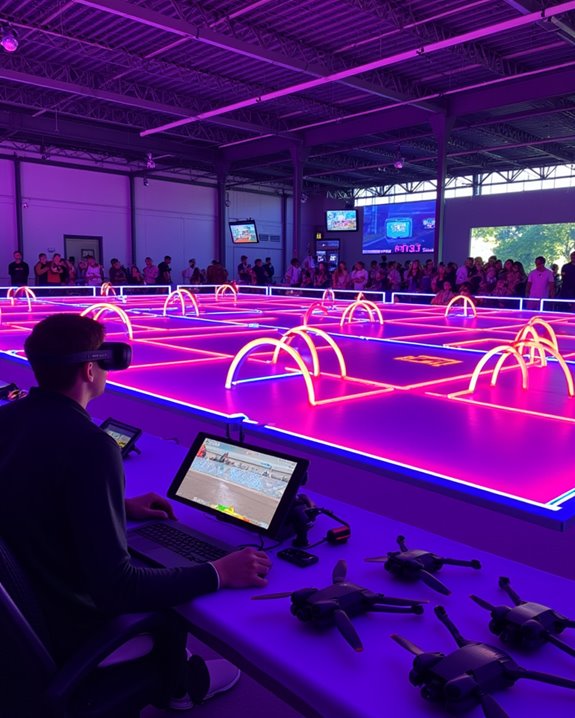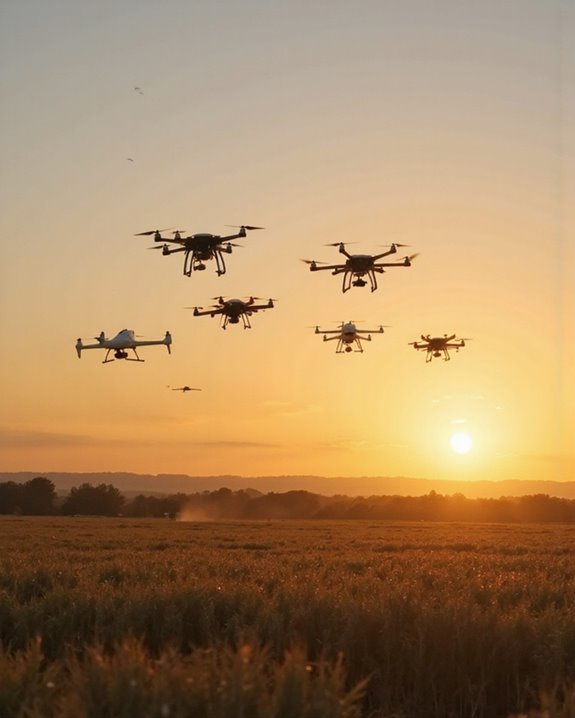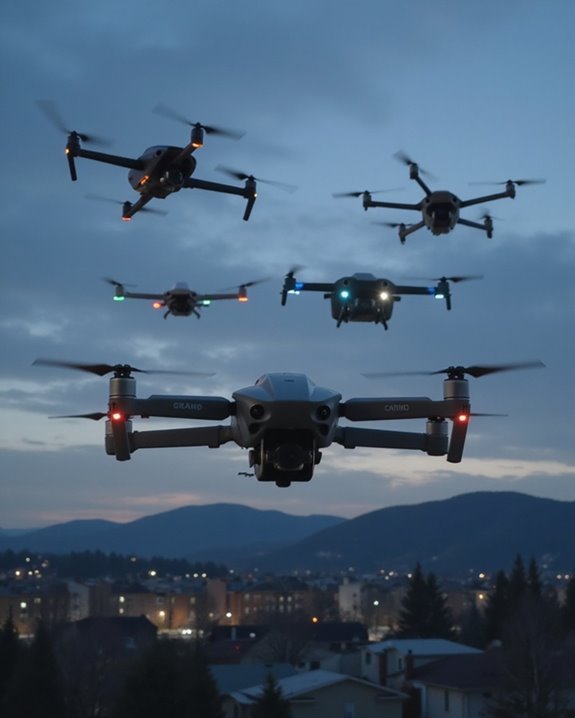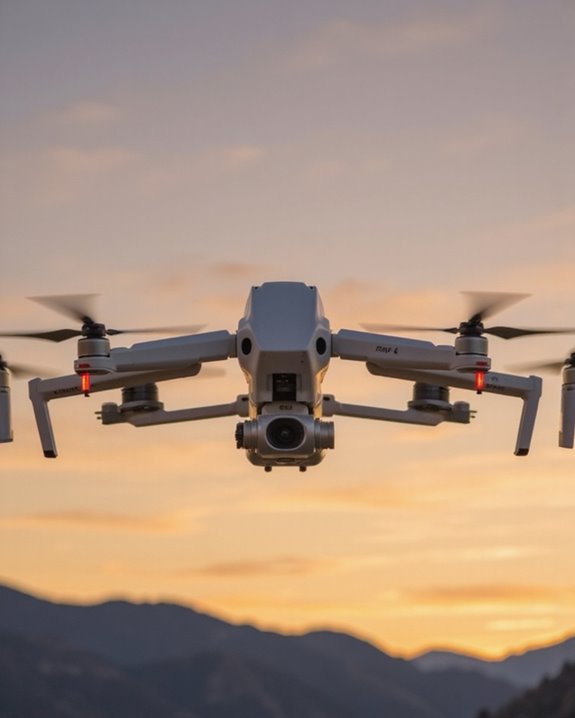For high-speed thrills, the Sky Viper Type-R tops our list with impressive 30+ mph speeds and a 2:1 power-to-weight ratio! The Ruko F11PRO 2 offers professional 6K footage on a 3-axis gimbal, while the nimble Goosky Legend S1 excels with dual brushless motors. Don’t overlook the Holy Stone HS360E with its 4K camera and lightweight design, or the portable Drone Obstacle Course for creating your own racing challenges. Your perfect racing experience awaits in the details below!
Key Takeaways
- Racing drones require speeds exceeding 30 mph, with models like Sky Viper Type-R offering 75% more power than standard drones.
- Low latency control systems (under 100ms) are crucial for competitive racing to execute precise maneuvers with minimal delay.
- Lightweight designs (under 450g) improve agility, with power-to-weight ratios around 2:1 enhancing acceleration and performance.
- Multiple flight modes are essential, offering both stabilized options for beginners and advanced modes for experienced racers.
- Battery efficiency is critical, with high-capacity batteries (2100-3200mAh) providing longer flight times for practice and competitions.
Ruko F11PRO 2 Drone with 6K Camera and 3-Axis Gimbal
- 【Soar into Summer Memories】From backyard BBQs to your kid's first bike ride, these are the moments they'll remember. With crisp 6K photos and smooth 4K/30fps video,...
- 【Advanced Image Sensor Lens】F11PRO 2’s premium image sensor lens outshines standard lenses, capturing finer details and richer textures, bringing your world to life...
- 【Stability Redefined】Experience the advantage of our 3-axis brushless gimbal, which provides superior stability and smoothness. With enhanced wind resistance, you can...
The ultimate drone enthusiast, whether beginner or seasoned flyer, will find their match in the Ruko F11PRO 2 Drone. With a remarkable 70-minute flight time from two 3200mAh batteries, you’ll spend more time soaring and less time charging!
You’ll capture breathtaking footage with the 6K camera mounted on a 3-axis brushless gimbal, delivering professional-level stability even on breezy days. The 10000ft FPV transmission range means you can explore far and wide while maintaining crystal-clear visual contact. GPS flight modes like follow-me and orbit make complex shots simple, while beginner mode helps newcomers avoid those embarrassing “tree landings” we’ve all experienced. At just 357g, it’s lightweight but packed with premium features.
Best For: Drone enthusiasts seeking extended flight time, high-quality aerial photography capabilities, and advanced GPS features in a user-friendly package suitable for both beginners and experienced pilots.
Pros:
- Exceptional 70-minute total flight time with two included batteries provides ample opportunity for aerial photography and exploration
- Professional-grade image quality with 6K camera on 3-axis gimbal delivers stable, vibrant footage even in windy conditions
- Comprehensive feature set including 10000ft transmission range, multiple GPS flight modes, and beginner-friendly options make it versatile for various skill levels
Cons:
- Actual flight time may average closer to 30 minutes per battery rather than the advertised 35 minutes, according to user feedback
- At 357g, it’s lightweight but may struggle in stronger wind conditions despite enhanced wind resistance
- While marketed as a premium drone, it’s positioned in a mid-tier price category, which might not satisfy professional videographers seeking absolute top-tier performance
Sky Viper Type-R Racing Drone
- PERFORMANCE BY DESIGN - The all new TYPE R launches to the front of the Sky Viper pack with over 75% more power than our previous generation stunt drone. Bigger motors...
- SPORT & RACE FLIGHT MODES - Multiple modes make TYPE R perfect for both experts and beginners. Sport mode is perfect for spirited casual flying or if you’re just...
- ADVANCED FLIGHT SOFTWARE - Like all Sky Viper drones, TYPE R is packed with the latest technology to make flying easier. Advanced software and precision electronics...
Racing enthusiasts looking for serious power will find their match in the Sky Viper Type-R Racing Drone! With 75% more power than previous models and speeds exceeding 30 mph, you’ll feel the thrill of professional racing right in your backyard. The impressive 2:1 power-to-weight ratio delivers exceptional agility for those tight racing corners.
You’ll appreciate the versatility with Sport mode for casual flying and R mode when you’re ready to push limits. One-touch stunts let you perform barrel rolls and flips with ease, while the advanced flight software corrects for wind and keeps you stable. Just be prepared for a learning curve—some users report sensitivity issues that might send rookies into a few tree branches!
Best For: Racing drone enthusiasts ages 12+ who want a powerful racing experience with speeds over 30 mph and are willing to master responsive controls.
Pros:
- Impressive power with 75% increase over previous generation and speeds exceeding 30 mph
- Versatile flight modes with Sport mode for casual flying and R mode for racing performance
- One-touch stunts capability including barrel rolls and flips with advanced stability correction
Cons:
- Short battery life with only an 800 mAh battery that requires frequent recharging
- Highly sensitive controls that can be challenging for beginners to master
- Durability concerns based on customer feedback about crashes and returns
Goosky Legend S1 3D Mini RC Helicopter with T8 Transmitter
- The GOOSKY Legend S1 is a small, game-changing, high-performance, aerobatic helicopter that incorporates all the latest in cutting-edge design and technology to bring...
- It boasts a whole host of features including dual direct drive powerful brushless motors (one main, one tail), a compact GTS control system with Bluetooth mobile phone...
- Every detail reflects the ingenuity of the designers in producing a tough, easy-to-fly, maintenance-free, high-performance helicopter suitable for entry-level and...
Designed for intermediate pilots seeking both stability and aerobatic capabilities, Goosky Legend S1 3D Mini RC Helicopter delivers impressive performance in a compact package. You’ll appreciate its dual brushless motors and lightweight 107g design that enables nimble maneuvers while maintaining control.
The included T8 transmitter gives you impressive 300m range, perfect for outdoor flying sessions. With two distinct flight modes—self-stabilization for beginners and 3D aerobatics for when you’re feeling adventurous—this little powerhouse adapts to your skill level! Its quick-change battery system lets you swap power in seconds, though the 8-minute flight time might leave you wanting more. Overall, it’s a solid choice for anyone looking to step up their RC helicopter game.
Best For: Intermediate RC helicopter enthusiasts seeking a lightweight, versatile mini helicopter that offers both stability for learning and advanced capabilities for aerobatic flying.
Pros:
- Dual brushless motors and lightweight design (107g) provide excellent maneuverability and control for advanced flying techniques
- Versatile dual flight modes (self-stabilization and 3D aerobatics) accommodate skill progression and different flying preferences
- Impressive 300m control range with the T8 transmitter makes it suitable for spacious outdoor environments
Cons:
- Limited 8-minute flight time may feel restrictive during practice sessions
- Despite being labeled for ages 12 months-4 years in the product information, this is clearly an intermediate-level RC helicopter requiring significant skill
- At #193080 in Toys & Games rankings, it may not be as popular or widely tested as other RC helicopter options
Holy Stone HS360E GPS Drone with 4K Camera
- Upgraded Drone for Adults: The 𝐇𝐨𝐥𝐲 𝐒𝐭𝐨𝐧𝐞 𝐇𝐒𝟑𝟔𝟎𝐄 is the 𝐞𝐧𝐡𝐚𝐧𝐜𝐞𝐝 𝐯𝐞𝐫𝐬𝐢𝐨𝐧...
- 𝟒𝐊 𝐄𝐈𝐒 𝐂𝐚𝐦𝐞𝐫𝐚 with 𝟏𝟐𝟎𝟎𝐖 𝐒𝐞𝐧𝐬𝐨𝐫: Capture professional-level videos and photos with the drone’s 4K...
- 𝟐𝟎,𝟎𝟎𝟎𝐟𝐭 𝐋𝐨𝐧𝐠-𝐑𝐚𝐧𝐠𝐞 𝐓𝐫𝐚𝐧𝐬𝐦𝐢𝐬𝐬𝐢𝐨𝐧: Enjoy long-distance control and real-time video with...
Weighing just 249g, this ultra-lightweight marvel is perfect for drone enthusiasts who don’t want to deal with FAA registration hassles! The HS360E packs impressive features into its foldable frame, including a stunning 4K camera with electronic image stabilization that’ll make your aerial footage look professionally smooth.
You’ll love the intelligent flight modes like follow-me and waypoint navigation, which let you focus on capturing the perfect shot while the drone handles the flying. With an impressive 4-mile range and brushless motors for stable flight, you’re getting serious performance that won’t break the bank! The included carrying case and spare propellers mean you’ll be ready for adventure right out of the box.
Best For: Beginner to intermediate drone enthusiasts looking for a lightweight, portable camera drone with advanced features that doesn’t require FAA registration.
Pros:
- Impressive 4K camera with electronic image stabilization delivers professional-quality aerial footage
- Lightweight 249g design makes it highly portable and exempt from FAA registration requirements
- Intelligent flight modes like GPS auto-return, follow me, and waypoint navigation enhance the flying experience
Cons:
- 2100mAh battery capacity may limit flight time compared to larger drones
- 4.2-star rating from 895 reviews suggests some users may have experienced issues
- While it has a 4-mile maximum range, real-world performance may vary depending on environmental conditions
Drone Obstacle Course with 3 Easy-to-Build Hoops for FPV Racing
- Complete Obstacle Course for FPV Racing Excitement: Featuring 3 pack of easy-to-build obstacle hoops that enhance your flying skills and fun. Configure 3-loop racing...
- Designed for Skill Enhancement & Competition: Perfectly crafted for FPV thrill-seekers and obstacle avoidance training. Suitable for kids and adults alike, it's a...
- Built to Last with Durable Materials: Each component is crafted from top-notch, durable materials that withstand the rigors of intense racing action. This ensures...
Elevating your drone racing experience has never been more accessible than with this 3-pack of easy-build obstacle hoops! These blue FPV loop gates snap together quickly, creating customizable racing routes that’ll test your piloting skills while keeping the fun factor high. You’ll appreciate how easily they disassemble for storage after your racing sessions.
At just 450 grams, these durable plastic hoops can withstand intense racing action yet remain portable enough to take anywhere. Perfect for ages 6 and up, they’re equally suitable for backyard beginners or competitive racers. For $33, they’re a steal, though you might want to add lights or anchors on windy days!
Best For: Beginner to intermediate drone pilots ages 6 and up who want to improve their flying skills through fun obstacle course racing in indoor or outdoor settings.
Pros:
- Easy snap-together assembly with no tools required makes setup quick and straightforward for users of all ages
- Lightweight (450g) and portable design allows for convenient transportation and storage when not in use
- Affordable price point at $33 delivers excellent value for creating customizable racing courses
Cons:
- Thin profile and lightweight construction makes hoops susceptible to movement in windy conditions
- No lighting included, limiting visibility and usability in low-light environments
- May require additional anchoring or stabilization for consistent performance on uneven surfaces
Factors to Consider When Choosing Drone Racing

When choosing your ideal racing drone, you’ll need to weigh several critical factors that can make or break your competitive experience. You’ll want to evaluate the drone’s speed and power capabilities, flight time, control responsiveness, crash resistance, and video quality—each element plays a vital role in your racing success! These considerations will help you find the perfect balance between performance and reliability, ensuring you’re not left watching from the sidelines while your competitors zoom through the course.
Speed and Power Capabilities
Just how fast can your racing drone go? Today’s competitive models regularly exceed 30 miles per hour, giving you that key edge on the racecourse! When selecting your drone, look for a power-to-weight ratio of about 2:1, which will deliver the snappy acceleration and responsiveness you’ll need for those hairpin turns.
You’ll want motors that provide up to 75% more thrust than standard drones, allowing you to maintain top speeds even through complex maneuvers. This extra power isn’t just for straight-line speed—it’s what enables those jaw-dropping barrel rolls and split-second direction changes. Plus, advanced power systems help your drone stay stable at high velocities, automatically correcting for wind gusts that would send lesser models tumbling. Remember, in drone racing, power isn’t just about going fast—it’s about staying fast through the entire course!
Flight Time and Endurance
The delicate balance between flight time and endurance represents one of the most crucial factors in competitive drone racing. You’ll quickly discover that even the fastest drone becomes useless when its battery dies mid-race! Most racing drones offer between 8-70 minutes of flight time, with your specific needs determining the ideal duration for your racing style.
Your battery capacity makes all the difference—an 800mAh battery might leave you rushing to the pit stop, while a hearty 3200mAh could keep you zooming through additional laps. Don’t forget that weight matters too; lighter drones with efficient motors will stretch your airtime considerably. When selecting your racing companion, you’re basically choosing a strategy: do you want a quick, powerful burst or consistent performance over extended races? The right balance will keep you competitive when others are grounded!
Control System Responsiveness
How quickly does your drone respond when you flick that control stick? In competitive racing, those milliseconds matter! The best systems deliver under 100ms latency, giving you that vital edge when maneuvering hairpin turns at 30+ mph.
Your drone’s responsiveness hinges on several factors, including signal frequency and transmission tech. Many top racers prefer 2.4 GHz systems to minimize interference and maintain crisp control. The difference between winning and crashing might be just 10-20 milliseconds of delay!
Look for drones featuring advanced stabilization algorithms that achieve lightning-fast 20-50ms response times. These systems let you execute those jaw-dropping flips and rolls with butter-smooth precision. Remember, when you’re threading the needle through tight racing gates, your drone’s ability to respond instantly to your commands isn’t just nice—it’s essential.
Durability and Crash Resistance
Crash-proofing your racing drone isn’t just smart—it’s essential for survival in the high-stakes world of competitive flying! When you’re zipping through obstacles at breakneck speeds, your drone needs to withstand the inevitable bumps and tumbles without falling to pieces.
Look for models with reinforced structures like protective cages or frames that absorb impact energy. Materials matter tremendously here—high-toughness components can mean the difference between a quick reset and a trip to the repair bench! While lighter drones (under 1 pound) offer fantastic agility, don’t sacrifice durability for weight savings. The sweet spot is that perfect balance of nimbleness and toughness.
Most racers find that drones with stability features like electronic image stabilization and wind resistance technology crash less frequently—saving you both money and frustration in the long run!
Camera and Video Quality
While your drone’s frame needs to take a beating, your eyes need crystal-clear video during every heart-pounding race! The difference between victory and crashing into a gate often comes down to what you can see through your goggles.
Aim for higher resolutions like 4K for those razor-sharp details that’ll help you thread needles through tight courses. Electronic image stabilization is your best friend, reducing shake from those aggressive turns and keeping your view steady when wind tries to throw you off course. Don’t settle for sluggish frame rates—30fps minimum keeps everything fluid and responsive! Advanced CMOS sensors will serve you well in changing light conditions, whether you’re racing at high noon or during golden hour. And remember, transmission range matters—you’ll want those clear video feeds maintained across the entire course, no exceptions!
Size and Weight Class
The perfect racing drone balances between featherlight agility and rock-solid stability! When selecting your racing companion, you’ll need to evaluate whether to go lightweight (under 250 grams) or opt for a heavier class. Those sub-250g models aren’t just travel-friendly—they’ll zip through tight corners with incredible responsiveness and often bypass certain regulations, making your racing life simpler.
Heavier drones, while not as nimble, won’t get pushed around by wind gusts during those high-speed straightaways. They’ll give you consistent performance when conditions get rough! Your choice ultimately affects flight time too; lighter drones might give you a thrilling but brief 8-minute session, while their bulkier cousins can stay airborne longer. Remember, your drone’s weight-to-power ratio directly impacts how fast you’ll cross that finish line!
Flight Mode Options
Moving beyond size considerations, every winning racer knows that mastering flight modes can make the difference between podium finishes and disappointing crashes! Your drone’s stability mode is your best friend when learning the ropes, automatically adjusting for pesky wind gusts while you focus on nailing those tight turns.
As your skills improve, you’ll want to explore sport modes that unlock speeds over 30 mph with hair-trigger responsiveness. Nothing beats the rush of executing perfect barrel rolls in acrobatic mode to shave precious seconds off your lap time! For strategic racers, waypoint automation lets you pre-program consistent flight paths up to several miles long. Remember, the best pilots customize their flight modes to match the course—beginners can start with simplified controls, while pros might prefer full manual settings for those razor-thin victory margins!
Frequently Asked Questions
What Licenses or Permits Do I Need for Drone Racing?
For fast, fun flying adventures, you’ll need several specific permits. You must register your drone with the FAA and obtain a Remote Pilot Certificate (Part 107 license) if racing commercially. Many racing leagues require membership credentials, and you’ll need permission from property owners where you’re zipping through courses. Local parks might demand special event permits too! Check with your city ordinances, as some areas have restricted drone zones that could ground your racing dreams before takeoff.
How Long Does It Take to Become Proficient at Drone Racing?
Becoming proficient at drone racing typically takes 3-6 months of consistent practice. You’ll start mastering basic controls within a few weeks, but developing the reflexes and spatial awareness for competitive racing requires dedicated practice sessions, ideally 2-3 times weekly. Many pilots use simulators to accelerate their progress—they’re fantastic for winter months or rainy days! Everyone learns at different speeds, though, so don’t get discouraged if your buddy picks it up faster. Your “aha moment” will come when you least expect it!
Are There Age Restrictions for Competitive Drone Racing Events?
Age restrictions for competitive drone racing vary, but you’ll find most events require pilots to be at least 12-16 years old. The Drone Racing League (DRL), one of the biggest competitions, typically sets 16 as their minimum age, while some local events are more flexible. Many youth-specific tournaments welcome younger racers, too! Remember, these restrictions exist for safety and liability reasons, but don’t worry—if you’re a young enthusiast, there are plenty of junior leagues where you can hone your skills before hitting the big leagues.
What Are the Typical Costs of Maintaining a Racing Drone?
You’ll spend about $20-30 per month on racing drone maintenance, with propellers being your most frequent replacement at $2-5 per set. Batteries ($20-40 each) need replacement every 6-12 months, while motors ($15-25 each) typically last longer unless crashed. Don’t forget the occasional frame repairs ($10-30) and electronic component replacements! Your biggest expense might be the “oops tax” – those unexpected repairs after an ambitious maneuver sends your drone into a tree!
Can Racing Drones Be Used for Professional Videography Work?
While racing drones aren’t designed for professional filming, you’d be surprised how versatile they can be! With modifications like HD cameras and gimbal stabilizers, your racing drone can capture dynamic footage that’s impossible with traditional equipment. The small size lets you navigate tight spaces, and their speed creates exciting, high-energy shots. You’ll need to upgrade from standard FPV cameras, though. Many filmmakers use racing drones for those jaw-dropping chase sequences and breathtaking reveals that wow audiences!










